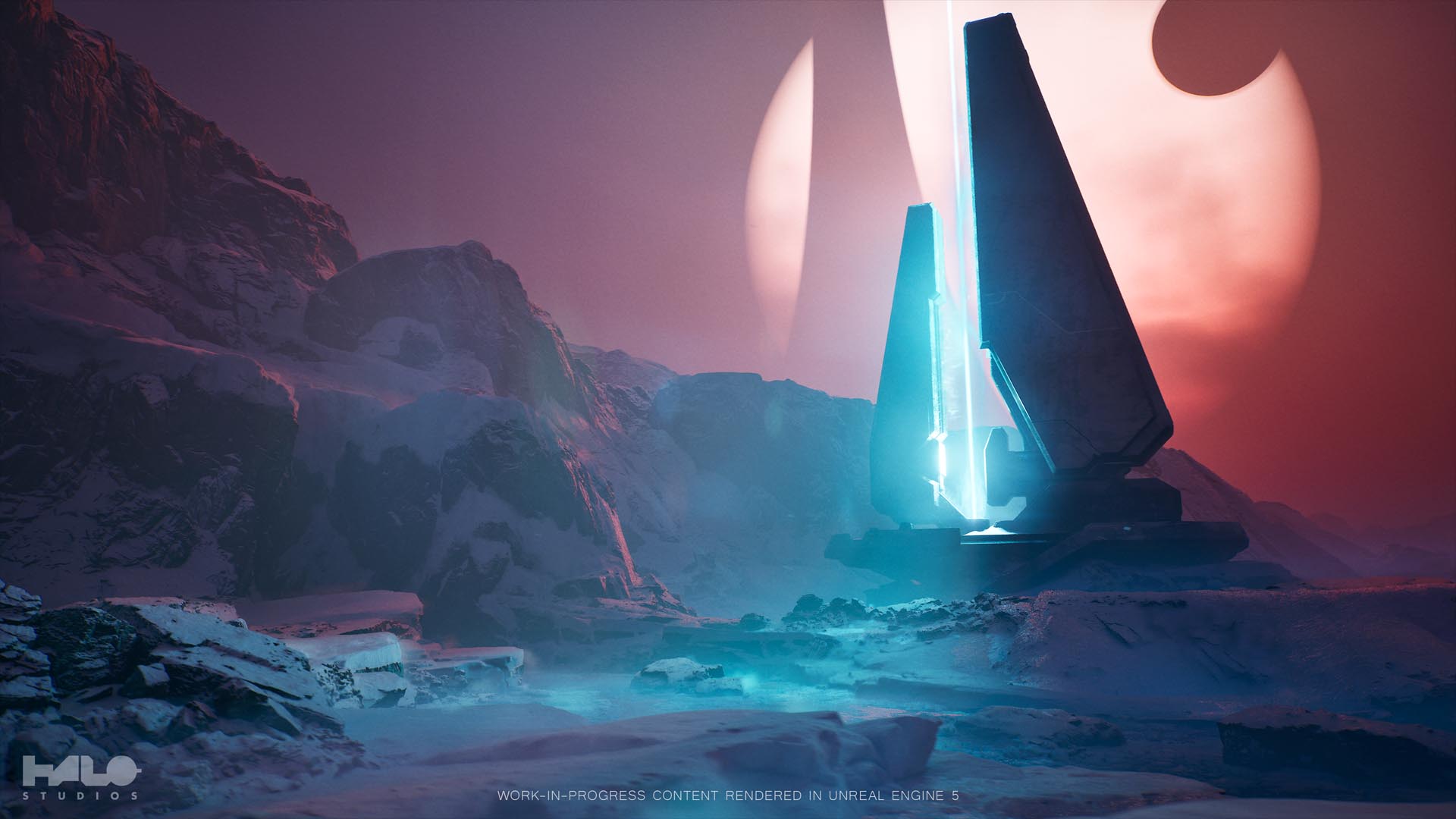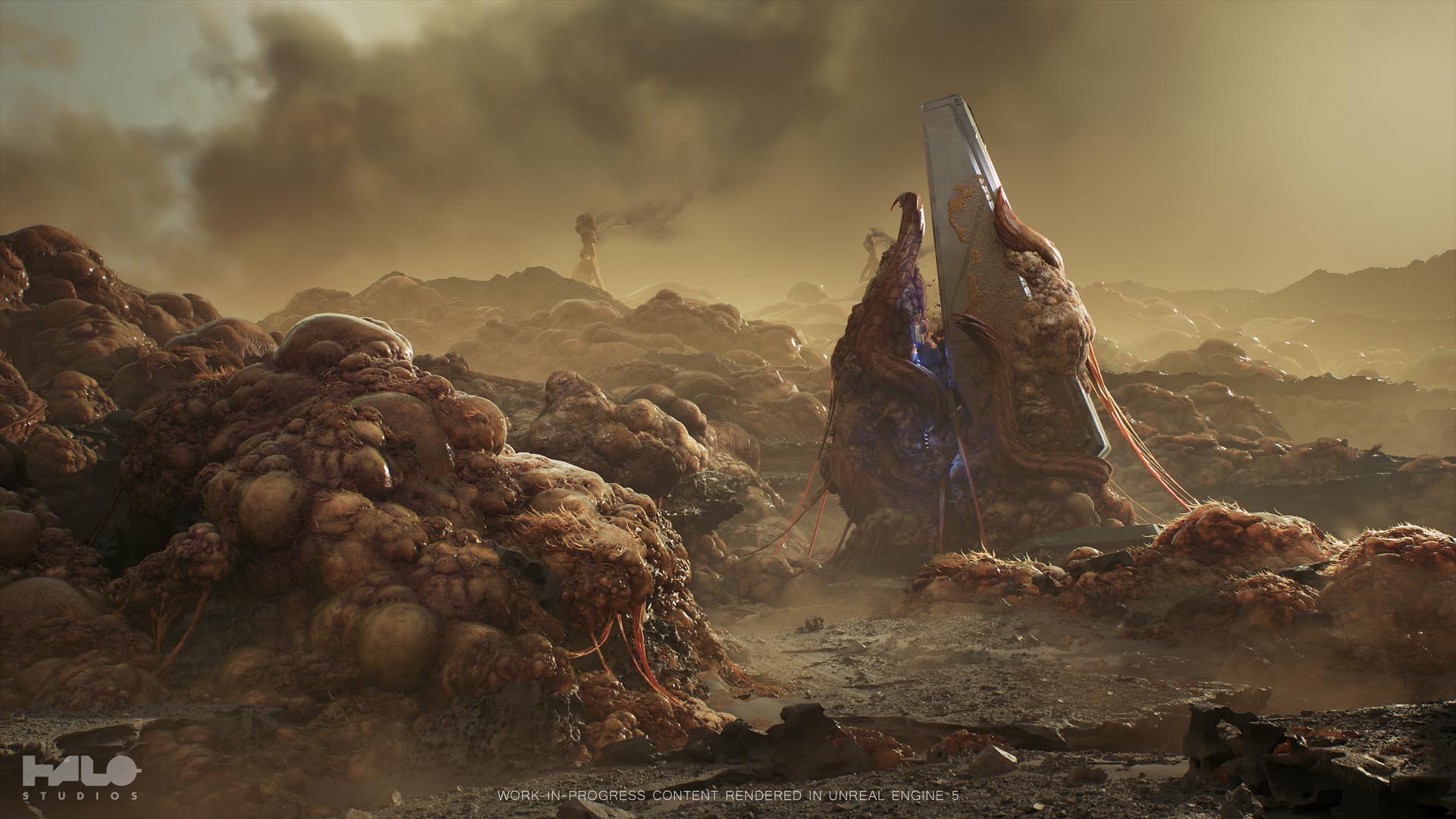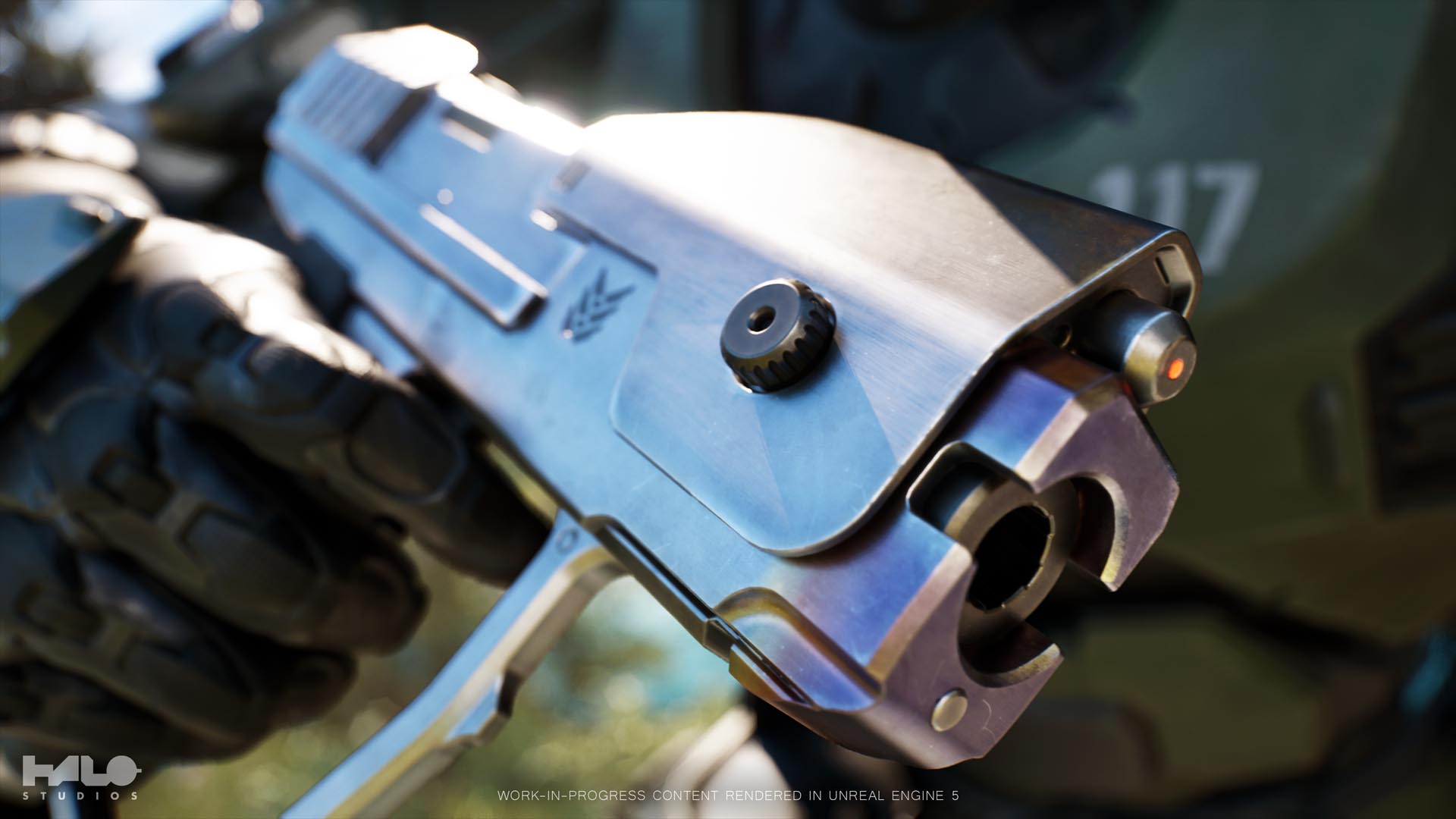Halo Studios: New Name, New Engine, New Games, New Philosophy
Ahead of the final match at today’s 2024 Halo World Championship, we saw an unexpected video. It depicted landscapes you might expect from the Halo series – Forerunner architecture jutting from dramatic landscapes inspired by the Pacific Northwest, gorgeous fields of ice, even a vista blighted and consumed by The Flood. We of course saw glimpses of the Master Chief, and his iconic enemies, even a Banshee arcing past the camera. But what we saw wasn’t a look back – this was something entirely new.
We’re entering a new dawn for Halo. Those new visuals were created using Unreal Engine 5 – and we learned that all future Halo projects will use the engine, and that multiple new games using it are in development. Alongside the engine change, the studio is seeing changes in culture, workflow, and how its teams are organized. To match that new approach, franchise stewards 343 Industries are changing their name – Halo Studios is here.
Studio Head Pierre Hintze defines this less like a clean break, and more like the turning of a page:
“If you really break Halo down, there have been two very distinct chapters. Chapter 1 – Bungie. Chapter 2 – 343 Industries. Now, I think we have an audience which is hungry for more. So we’re not just going to try improve the efficiency of development, but change the recipe of how we make Halo games. So, we start a new chapter today.”
The First Step
Switching from the studio’s proprietary Slipspace Engine to Unreal is a key part of that change. Previously, 343 Industries needed a large portion of its staff simply to develop and upkeep the engine its games ran on. “We believe that the consumption habits of gamers have changed – the expectations of how fast their content is available,” says Hintze. “On Halo Infinite, we were developing a tech stack that was supposed to set us up for the future, and games at the same time.”
As gaming evolves, and players increasingly point out how long it takes to see new games from their favorite series, the team at Halo Studios felt the need to react. As COO Elizabeth van Wyck puts it:
“The way we made Halo games before doesn’t necessarily work as well for the way we want to make games for the future. So part of the conversation we had was about how we help the team focus on making games, versus making the tools and the engines.”
Alongside the wider changes to how the studio is set up (which you can read more about below), adopting Unreal means Halo Studios is more able to create games with a focus that can satisfy fans – even setting up multiple teams to create different games simultaneously. But Unreal also comes with in-built benefits that would have taken years of work to replicate with Slipspace:
“Respectfully, some components of Slipspace are almost 25 years old,” explains Studio Art Director, Chris Matthews. “Although 343 were developing it continuously, there are aspects of Unreal that Epic has been developing for some time, which are unavailable to us in Slipspace – and would have taken huge amounts of time and resources to try and replicate.

“One of the primary things we’re interested in is growing and expanding our world so players have more to interact with and more to experience. Nanite and Lumen [Unreal’s rendering and lighting technologies] offer us an opportunity to do that in a way that the industry hasn’t seen before. As artists, it’s incredibly exciting to do that work.”
There’s another in-built benefit – Unreal is familiar to huge parts of the wider gaming industry. Where developers would have to spend time learning how to use Slipspace when joining 343, Halo Studios’ adoption of the industry-leading engine makes it a far smoother process to bring in new talent (and the studio is indeed hiring for its new projects now):
“It’s not just about how long it takes to bring a game to market, but how long it takes for us to update the game, bring new content to players, adapt to what we’re seeing our players want,” says Van Wyck. “Part of that is [in how we build the game], but another part is the recruiting. How long does it take to ramp somebody up to be able to actually create assets that show up in your game?”
With the move to Unreal, the on-ramp is shorter, the experience is there, and the series can grow far more quickly and organically than ever before.
Forging Ahead
Of course, Halo Studios needed to be confident in the switch to Unreal – this isn’t a decision taken lightly. The team had to be sure that the first Halo games to come out of a non-Slipspace engine would look, feel, and sound right. The team began experimenting, and it resulted in a research project known as Project Foundry – the source for all the new clips we saw today.
“When we decided to do Foundry, it wasn’t, at that point, in our plan,” says Van Wyck. “But we needed to pause and – ‘validate’ is not the right word, but educate and understand what our capability is, and assess it, so we actually know we’re on the right path.
“We’ve intentionally been really quiet up to this point, but I think [today] is about just sharing where we are, what our priorities are as a studio, and where the team is. We’re really proud of what came out of Foundry.”

So what does Foundry represent? The team is clear that this is not a new game – but nor is it a traditional tech demo. It isn’t just an exploration of what’s possible with this engine – it’s a true reflection of what would be required for a new Halo game using Unreal, and a training tool for how to get there. Foundry has been made with the same rigor, process, and fidelity as a shipped game would be.
“Where this type of work’s been done historically, across the industry, it can contain a lot of smoke and mirrors,” explains Matthews. “It sometimes leads players down paths where they believe it’s going to be one thing, and then something else happens. The ethos of Foundry is vigorously the opposite of that.
“Everything we’ve made is built to the kind of standards that we need to build for the future of our games. We were very intentional about not stepping into tech demo territory. We built things that we truly believe in, and the content that we’ve built – or at least a good percentage of it – could travel anywhere inside our games in the future if we so desire it.”
Hintze goes further: “It’s fair to say that our intent is that the majority of what we showcased in Foundry is expected to be in projects which we are building, or future projects.”
And what we’ve seen of Foundry promises incredible things. Named after the Foundry within Halo’s lore – the central forge of the megastructure used to create the Halo Rings themselves – the project saw the team set out to create three distinct biomes in the style of Halo. The goal was, as Matthews puts it, to make something old, something new, and something truly alien.
For something old, we see a biome inspired by the Pacific Northwest – a staple of the series – but in dramatic new form. Waterfalls crash over mountains, a running creek becomes the site of a tableau pitching the Chief against two Covenant Elites, and the team pushed Unreal to include as much foliage as technically possible.

For something new, we see the Coldlands location, a region locked in a deep freeze, with snowdrifts covering plateaus, and ice reflecting what’s above and refracting what’s below. And for something alien, we see the Blightlands, a brand new take on a Halo location – a world consumed by the parasitic Flood. The express purpose of the Blightlands was to see how this new-look Halo team could push the world itself farther than previous Halo games – the results speak for themselves.
Even the familiar looks new in Foundry. The Chief’s armor has been modelled with extreme care, down to individual panels on his combat gloves. An Elite’s energy sword now feels less like a solid object and more reflective of the name – a crackling swoosh of dangerous energy. The aim wasn’t just to push the studio, but the engine itself – Foundry is designed to do things that we haven’t seen in games using Unreal across the industry, Halo began its life as a graphical showcase for the original Xbox – the goal is to make that so again.
Halo Studios has worked closely with Unreal’s creators, Epic Games, to ensure they can reach that lofty goal.
“Halo is such an incredible franchise and it’s awesome to see Halo Studios already pushing the boundaries of Unreal Engine 5,” said Bill Clifford, Vice President and General Manager of Unreal Engine at Epic Games. “We’re honored to support the Halo team in realizing their creative visions through Unreal Engine. Project Foundry’s work demonstrates how they can bring Halo to life with beautifully detailed, uncompromised worlds.”
Of course, the soul of Halo isn’t just in how it looks, but how it feels – the intrinsic dance of its combat, the thud of the weapons, and the sense that you’re inhabiting the Master Chief’s armor. While Foundry may be a primarily visual project, Halo Studios is deeply invested in retaining the essence of what players love about Halo:

“I think it’s pretty well known that [switching engine] has been a topic that the studio has thought about for a long, long time,” says Van Wyck. “[The release of] Unreal Engine 5 was when we felt like we could make Halo games that respect and reflect the true soul of Halo while also being able to build games that can deliver on the scale and ambition of content that players want.”
“The spirit of Halo is more than just the visuals,” agrees Matthews. “It’s the lore. It’s the physics. Playing as the Chief, you’re this huge tank of a soldier – it’s the way that he moves, he feels. We’re all really obsessed about what our players love about Halo. We’re constantly listening to this feedback – and that’s at the core of any initiative like Foundry, or any intention that the studio has about how we move forwards.”
“We’re thinking about the intangibles,” Hintze adds. “The interaction with the Master Chief, or your Spartan, or the enemies. We are very careful about the decisions we’re making in that space – down to the precision and authenticity of the weapons, the authenticity of the animations. There are a list of nuances which we use to verify that we’re on track.”
Beyond the Visor
So, let’s talk about what’s coming beyond Foundry. As you might expect, the team isn’t talking about exactly what those new games will be right now – we’re at the beginning of this new chapter, not the final stages, and it’s fair to say that a new Halo game isn’t imminent. Halo Infinite will still be supported through the Slipspace Engine – you can expect more Operations, and updates to its Forge mode. In esports, Year 4 of the Halo Championship Series, using Halo Infinite, has just been announced. But in the background, the next steps for Halo will be taken.
The quietness is by design. Hintze makes clear that the priority right now is on doing the work, not simply talking about it:
“One of the things I really wanted to get away from was the continued teasing out of possibilities and ‘must-haves’. We should do more and say less. For me, I really think it is important that we continue the posture which we have right now when it comes to our franchise – the level of humility, the level of servitude towards Halo fans.
“We should talk about things when we have things to talk about, at scale. Today, it’s the first step – we’re showing Foundry because it feels right to do so – we want to explain our plans to Halo fans, and attract new, passionate developers to our team. The next step will be talking about the games themselves.”

What is clear is that, yes, it’s Halo games – plural – in development right now. Where Halo Infinite saw practically the entire studio focused on a single, evolving project, Halo Studios has recalibrated:
“We had a disproportionate focus on trying to create the conditions to be successful in servicing Halo Infinite,” says Hintze. “[But switching to Unreal] allows us to put all the focus on making multiple new experiences at the highest quality possible.”
A major part of this shift has been in reorganizing the structure of Halo Studios as a whole, in order to give development teams what they need to make something new.
“At the end of the day, if we build the games that our players want to play, that’s how we’ll be successful,” explains Van Wyck. “That’s what should motivate what we build. That’s also what this structure has done – we want the people that are day-in-day-out making the games to be the ones to make the decisions on the games.”
The team will also be seeking more input from outside the studio on those decisions:
“We’re seeking earlier and earlier, wider and wider feedback from our players,” she continues. “We started that with The Master Chief Collection, and carried that on with Halo Infinite, and we want to do it even more for our next projects. At the end of the day, it’s not just how do we evaluate, it’s how do our players evaluate it?”
343 Industries was founded to create Halo games but the impression I get is that, in its new incarnation as Halo Studios, the studio has been retooled to put the focus entirely on that goal – without distraction, without impediment, to create better games with players’ hopes and wishes at the heart of the endeavor.
“You asked why we consider this as a new chapter,” says Hintze. “We want a singular focus. Everyone is in this place is here to make the best possible Halo games.”
The post Halo Studios: New Name, New Engine, New Games, New Philosophy appeared first on Xbox Wire.
Source: Xbox Blog
—